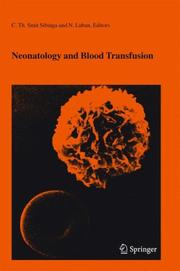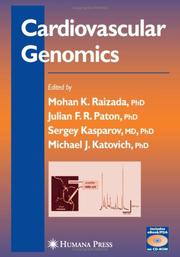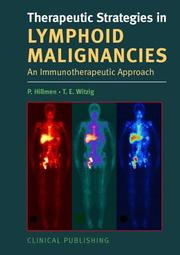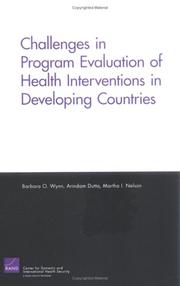| Listing 1 - 6 of 6 |
Sort by
|

ISBN: 9780387236001 038723599X 9780387235998 1441936416 9786612823862 1282823868 0387236007 Year: 2005 Publisher: Netherlands : Springer,
Abstract | Keywords | Export | Availability | Bookmark
 Loading...
Loading...Choose an application
- Reference Manager
- EndNote
- RefWorks (Direct export to RefWorks)
Neonatology and Blood Transfusion Proceedings of the Twenty-Eighth International Symposium on Blood Transfusion, Groningen, NL, Organized by the Sanquin Division Blood Bank North-East, Groningen It is in many ways fitting that the last of these international symposia on blood transfusion should end with neonatal blood transfusion. The most fragile, least well studied and most at risk population requires special care and concern. We need to expand our knowledge of their unique physiology, biochemical pathways and in planning treatment and interventions, always "do no harm." This proceedings of the last Groningen symposium presents a wealth of information on developmental immunology, the molecular basis of haematopoeisis, physiological basis of bleeding and thrombosis, transfusion risks and benefits and lastly, future therapies. Infants provide us with much to learn but in turn they will be the providers of (through cord blood) and the recipients of (through cellular engineering) the best that science can offer. Translational research, which has been the thrust of these presentations for 28 years, will benefit them in a way that no scientist could have ever predicted.
Medicine & Public Health. --- Hematology. --- Blood Transfusion Medicine. --- Medicine. --- Blood transfusion. --- Médecine --- Hématologie --- Blood transfusion -- Methods -- Congresses. --- Neonatology. --- Infant, Newborn --- Blood Transfusion --- Infant --- Biological Therapy --- Age Groups --- Therapeutics --- Persons --- Analytical, Diagnostic and Therapeutic Techniques and Equipment --- Named Groups --- Hematologic Diseases --- Pathology --- Medicine --- Health & Biological Sciences --- Hematology --- Neonatology --- Neonatal pediatrics --- Haematology --- Perinatology --- Newborn infants --- Internal medicine --- Blood --- Diseases --- Blood transfusion --- Blood transfusion therapy --- Hemotherapy --- Transfusion medicine --- Transfusion of blood --- Transfusion therapy --- Transfusion therapy, Blood --- Surgery --- Blood banks --- Blood groups --- Hospitals --- Transfusion-free surgery --- Transfusion committees

ISBN: 9781588294005 1588294005 9781592598830 161737542X 9786610359370 1280359374 1592598838 Year: 2005 Publisher: Totowa, N.J. : Humana Press,
Abstract | Keywords | Export | Availability | Bookmark
 Loading...
Loading...Choose an application
- Reference Manager
- EndNote
- RefWorks (Direct export to RefWorks)
After more than 50 years of limited success in controlling blood pressure with traditional antihypertensive drugs, the time is ripe to explore alternate strategies for managing cardiovascular diseases. In Cardiovascular Genomics, recognized scientists and clinicians from around the world discuss the most recent molecular approaches to understanding the cardiovascular system in both health and disease. The authors focus on all components of the system, including blood vessels, heart, kidneys, and the brain, and cover disease states ranging from vascular and cardiac dysfunction to stroke and hypertension. The methods described for identifying the genes that cause susceptibility to cardiovascular diseases emphasize the possibility of discovering new drug targets. They involve genetic linkage analysis and substitution mapping using congenic strains, microarray techniques, and strategies for discovery in animal models of hypertension. The new transgenic mouse models that either over- or underexpress angiotensinogen are used to illuminate the function of the tissue renin-angiotensin systems, enhancing the understanding of the role of polymorphisms, a crucial factor for effective design of new drugs. The chapters on gene transfer and gene therapy cover a wide variety of topics ranging from novel clinical applications for treating stroke, coronary, and peripheral vascular diseases, to producing new cardiovascular cells and tissues, to using viral vectors as tools. A value-added compact disk containing a companion ebook version of Cardiovascular Genomics is included for downloading and use in the reader's PC or PDA. Authoritative and ground-breaking, Cardiovascular Genomics offers an unprecedented examination of both cutting-edge scientific approaches through the new science of cardiovascular genomics, and the efficacious results it is now possible to obtain.
Cardiovascular Diseases --- Cell Transplantation. --- Gene Therapy. --- Gene Transfer Techniques. --- Cardiovascular system --- Genomics. --- Appareil cardiovasculaire --- Génomique --- genetics. --- Diseases --- Genetic aspects. --- Maladies --- Aspect génétique --- Cardiovascular system -- Diseases -- Genetic aspects. --- Cardiovascular system. --- Genomics --- Genetic Techniques --- Biology --- Transplantation --- Biological Therapy --- Surgical Procedures, Operative --- Investigative Techniques --- Therapeutics --- Biological Science Disciplines --- Analytical, Diagnostic and Therapeutic Techniques and Equipment --- Natural Science Disciplines --- Disciplines and Occupations --- Cell Transplantation --- Genetics --- Gene Therapy --- Gene Transfer Techniques --- Medicine --- Health & Biological Sciences --- Genetic aspects --- Genome research --- Genomes --- Circulatory system --- Vascular system --- Research --- Medicine. --- Cardiology. --- Medicine & Public Health. --- Heart --- Internal medicine --- Clinical sciences --- Medical profession --- Human biology --- Life sciences --- Medical sciences --- Pathology --- Physicians --- Molecular genetics --- Blood --- Circulation

ISBN: 9781588291721 1588291723 9781592598519 9786610358199 128035819X 159259851X Year: 2005 Publisher: Totowa, N.J. : Humana Press,
Abstract | Keywords | Export | Availability | Bookmark
 Loading...
Loading...Choose an application
- Reference Manager
- EndNote
- RefWorks (Direct export to RefWorks)
Cell death, or apoptosis, plays an important role in biological processes and disease and offers special opportunities to develop new therapies for cancer, autoimmune disease, stroke, heart attack, and Alzheimer's disease. In Death Receptors in Cancer Therapy, leading physician-scientists and basic researchers review in depth our latest understanding of the molecular events that regulate cell death, illuminating those molecules that provide targets for agonists or antagonists designed to modulate death signaling for therapeutic purposes. The authors focus on the extrinsic system of death receptors, their regulation and function, and their abnormalities in cancer. Topics of particlar interest include resistance to apoptosis, TRAIL signaling, death receptors in embryonic development, mechanisms of caspase activation, and death receptor mutations in cancer. Additional chapters address death signaling in melanoma, synthetic retinoids and death receptors, the role of p53 in death receptor regulation, immune suppression of cancer, and combination therapy with death ligands. Authoritative and up-to-date, Death Receptors in Cancer Therapy offers a timely compendium of cell death signaling pathways for those seeking either a basic understanding of apoptosis or the knowledge needed to develop new therapeutics that will activate or block death signaling in disease.
Neoplasms --- Cell Death --- Gene Therapy --- Receptors, Tumor Necrosis Factor --- Apoptosis --- Cell receptors --- Cancer --- Cellular signal transduction --- Apoptose --- Récepteurs cellulaires --- Transduction du signal cellulaire --- immunology --- therapy --- methods --- Molecular aspects --- Aspect moléculaire --- Kanker --- Kanker ; moleculaire aspecten --- Apoptosis. --- Cancer -- Molecular aspects. --- Cell receptors. --- Cellular signal transduction. --- Biological Therapy --- Genetic Engineering --- Diseases --- Investigative Techniques --- Cell Physiological Processes --- Receptors, Cytokine --- Cell Physiological Phenomena --- Receptors, Immunologic --- Analytical, Diagnostic and Therapeutic Techniques and Equipment --- Genetic Techniques --- Therapeutics --- Receptors, Cell Surface --- Phenomena and Processes --- Membrane Proteins --- Proteins --- Amino Acids, Peptides, and Proteins --- Chemicals and Drugs --- Methods --- Medicine --- Biology --- Health & Biological Sciences --- Cytology --- Oncology --- Molecular aspects. --- Cellular information transduction --- Information transduction, Cellular --- Signal transduction, Cellular --- Cell membrane receptors --- Cell surface receptors --- Receptors, Cell --- Medicine. --- Oncology. --- Medicine & Public Health. --- Tumors --- Clinical sciences --- Medical profession --- Human biology --- Life sciences --- Medical sciences --- Pathology --- Physicians --- Bioenergetics --- Cellular control mechanisms --- Information theory in biology --- Binding sites (Biochemistry) --- Cell membranes --- Cell death

ISBN: 3540220933 9786610745173 1280745177 354026843X 3642421903 Year: 2005 Publisher: Berlin Heidelberg New York : Springer-Verlag,
Abstract | Keywords | Export | Availability | Bookmark
 Loading...
Loading...Choose an application
- Reference Manager
- EndNote
- RefWorks (Direct export to RefWorks)
This book gives an updated review of the state of the art in regenerative cell therapy in the fields of cardiology, hematology, pediatrics, neurology, orthopedics and infectious diseases. The book emphasizes clinical advances as proof of concept in cell therapy based on the revolutionizing observation that regeneration can occur throughout the body even in highly differentiated organs like the heart and the neuronal system. It provides examples of breakthroughs in the clinical implementation of adult stem cell therapy.
Cellular therapy. --- Regeneration (Biology). --- Stem cells -- Transplantation. --- Cellular therapy --- Regeneration (Biology) --- Stem cells --- Immunotherapy, Adoptive --- Tissue Engineering --- Regeneration --- Hematopoietic Stem Cell Transplantation --- Stem Cell Transplantation --- Regenerative Medicine --- Adoptive Transfer --- Cell Transplantation --- Medicine --- Biological Processes --- Culture Techniques --- Immunization, Passive --- Biological Phenomena --- Health Occupations --- Transplantation --- Clinical Laboratory Techniques --- Immunization --- Investigative Techniques --- Disciplines and Occupations --- Phenomena and Processes --- Surgical Procedures, Operative --- Immunotherapy --- Analytical, Diagnostic and Therapeutic Techniques and Equipment --- Immunologic Techniques --- Immunomodulation --- Biological Therapy --- Therapeutics --- Pharmacy, Therapeutics, & Pharmacology --- Oncology --- Health & Biological Sciences --- Transplantation. --- Stem cell transplantation --- Regenerative biology --- Regrowth (Biology) --- Medicine. --- Hematology. --- Oncology. --- Orthopedics. --- Pediatrics. --- Medicine & Public Health. --- Developmental biology --- Autotomy --- Wound healing --- Cell therapy --- Cells --- Therapy, Cellular --- Organotherapy --- Therapeutics, Physiological --- Transplantation of organs, tissues, etc. --- Cell transplantation --- Therapeutic use --- Oncology . --- Paediatrics --- Pediatric medicine --- Children --- Orthopaedics --- Orthopedia --- Surgery --- Haematology --- Internal medicine --- Blood --- Tumors --- Diseases --- Health and hygiene --- Tissue therapy

ISBN: 1904392520 9786610309740 1280309741 1846925568 Year: 2005 Publisher: Oxford : Atlas Medical Publishing Ltd,
Abstract | Keywords | Export | Availability | Bookmark
 Loading...
Loading...Choose an application
- Reference Manager
- EndNote
- RefWorks (Direct export to RefWorks)
Targeted therapies are the focus of much research in oncology. Encouraging results from the development of new monoclonal antibodies are revolutionizing clinical therapies and this is particularly the case for haematologic malignancies. The advent of immunotherapy heralds a new era particularly for patients who are refractory to more traditional therapies. Impressive results are evident using monoclonal antibodies (mAb) that a) bind with high specificity to cell-surface antigens, resulting in targeted killing of the malignant cells or b) are conjugated to radioisotopes, toxins, enzymes or drug
Cancer. --- Lymphatics. --- Lymphoma. --- Lymphoma --- Immunotherapy --- Lymphoproliferative Disorders --- Neoplasms by Histologic Type --- Immunomodulation --- Lymphatic Diseases --- Biological Therapy --- Immunoproliferative Disorders --- Neoplasms --- Immune System Diseases --- Diseases --- Therapeutics --- Hemic and Lymphatic Diseases --- Analytical, Diagnostic and Therapeutic Techniques and Equipment --- Diseases of Immune System --- Immune Diseases --- Immunological Diseases --- Immune Disorders --- Immunologic Diseases --- Disease, Immune --- Disease, Immune System --- Disease, Immunologic --- Disease, Immunological --- Diseases, Immune --- Diseases, Immune System --- Diseases, Immunologic --- Diseases, Immunological --- Disorder, Immune --- Disorders, Immune --- Immune Disease --- Immune Disorder --- Immune System Disease --- Immunologic Disease --- Immunological Disease --- Therapy --- Treatment --- Therapeutic --- Therapies --- Treatments --- Disease --- Benign Neoplasms --- Malignancy --- Neoplasia --- Neoplasm --- Neoplasms, Benign --- Cancer --- Tumors --- Benign Neoplasm --- Cancers --- Malignancies --- Neoplasias --- Neoplasm, Benign --- Tumor --- Germinoblastoma --- Lymphoma, Malignant --- Reticulolymphosarcoma --- Sarcoma, Germinoblastic --- Germinoblastic Sarcoma --- Germinoblastic Sarcomas --- Germinoblastomas --- Lymphomas --- Lymphomas, Malignant --- Malignant Lymphoma --- Malignant Lymphomas --- Reticulolymphosarcomas --- Sarcomas, Germinoblastic --- Disorder, Immunoproliferative --- Disorders, Immunoproliferative --- Immunoproliferative Disorder --- Biologic Therapy --- Biotherapy --- Therapy, Biological --- Biologic Therapies --- Biological Therapies --- Biotherapies --- Therapies, Biologic --- Therapies, Biological --- Therapy, Biologic --- Lymphatism --- Status Lymphaticus --- Disease, Lymphatic --- Diseases, Lymphatic --- Lymphatic Disease --- Immunomodulatory Therapy --- Immunomodulations --- Immunomodulatory Therapies --- Therapies, Immunomodulatory --- Therapy, Immunomodulatory --- Histological Type of Neoplasm --- Histological Types of Neoplasms --- Neoplasms by Histological Type --- Neoplasm Histological Type --- Neoplasm Histological Types --- Neoplasms Histological Type --- Neoplasms Histological Types --- Duncan Disease --- Epstein-Barr Virus Infection, Familial Fatal --- Epstein-Barr Virus-Induced Lymphoproliferative Disease In Males --- Familial Fatal Epstein-Barr Infection --- Immunodeficiency 5 --- Immunodeficiency, X-Linked Progressive Combined Variable --- Lymphoproliferative Disease, X-Linked --- Lymphoproliferative Syndrome, X-Linked, 1 --- Purtilo Syndrome --- X-Linked Lymphoproliferative Disease --- X-Linked Lymphoproliferative Disorder --- Duncan's Syndrome --- X-Linked Lymphoproliferative Syndrome --- Disease, Duncan --- Disease, X-Linked Lymphoproliferative --- Diseases, X-Linked Lymphoproliferative --- Disorder, Lymphoproliferative --- Disorder, X-Linked Lymphoproliferative --- Disorders, Lymphoproliferative --- Disorders, X-Linked Lymphoproliferative --- Epstein Barr Virus Induced Lymphoproliferative Disease In Males --- Epstein Barr Virus Infection, Familial Fatal --- Familial Fatal Epstein Barr Infection --- Immunodeficiency 5s --- Immunodeficiency, X Linked Progressive Combined Variable --- Lymphoproliferative Disease, X Linked --- Lymphoproliferative Diseases, X-Linked --- Lymphoproliferative Disorder --- Lymphoproliferative Disorder, X-Linked --- Lymphoproliferative Disorders, X-Linked --- Lymphoproliferative Syndrome, X-Linked --- Lymphoproliferative Syndromes, X-Linked --- Purtilo Syndromes --- Syndrome, Purtilo --- Syndrome, X-Linked Lymphoproliferative --- Syndromes, Purtilo --- Syndromes, X-Linked Lymphoproliferative --- X Linked Lymphoproliferative Disease --- X Linked Lymphoproliferative Disorder --- X Linked Lymphoproliferative Syndrome --- X-Linked Lymphoproliferative Diseases --- X-Linked Lymphoproliferative Disorders --- X-Linked Lymphoproliferative Syndromes --- Immunotherapies --- therapy --- Malignant Neoplasms --- Malignant Neoplasm --- Neoplasm, Malignant --- Neoplasms, Malignant --- Medical Oncology --- Hematologic Neoplasms --- Amyloidosis --- Immunity, Active --- Immunologic Techniques --- Immune System Disorders --- Disorder, Immune System --- Immune System Disorder --- Blood and Lymphatic System Disorders --- Combined Antibody Therapeutics --- Diagnostic Techniques and Procedures --- Immunotherapy. --- Lymphoproliferative Disorders. --- Neoplasms by Histologic Type. --- Immunomodulation. --- Lymphatic Diseases. --- Biological Therapy. --- Immunoproliferative Disorders. --- Neoplasms. --- Immune System Diseases. --- Disease. --- Therapeutics. --- Hemic and Lymphatic Diseases. --- Diagnostic Techniques and Procedures.

ISBN: 1282451294 9786612451294 083304818X 0833038524 9780833048189 9780833038524 Year: 2005 Publisher: Santa Monica, CA : RAND Corp.,
Abstract | Keywords | Export | Availability | Bookmark
 Loading...
Loading...Choose an application
- Reference Manager
- EndNote
- RefWorks (Direct export to RefWorks)
Health interventions that are effective in developed countries may not be as effective in developing countries given the differing social, economic, cultural, and infrastructure factors that may affect how an intervention program is implemented and its outcomes. However, rigorous evaluation of public health intervention programs in various resource-limited settings is needed to determine which interventions will work most effectively and to spend scarce resources wisely. This monograph is intended to promote an understanding of why program evaluation is a critical component of any health inter
Communicable Disease Control -- methods. --- Developing Countries. --- Health Policy. --- Medical policy. --- Program Evaluation -- methods. --- Vaccination -- methods. --- World Health. --- World health --- Medical policy --- Program Evaluation --- Health Policy --- Vaccination --- Methods --- World Health --- Developing Countries --- Communicable Disease Control --- Immunotherapy, Active --- Immunization --- Public Policy --- Investigative Techniques --- Health --- Quality of Health Care --- International Cooperation --- Public Health Practice --- Evaluation Studies as Topic --- Health Care Evaluation Mechanisms --- Social Control Policies --- Population Characteristics --- Health Services Administration --- Public Health --- Analytical, Diagnostic and Therapeutic Techniques and Equipment --- Primary Prevention --- Internationality --- Policy --- Environment and Public Health --- Health Care Quality, Access, and Evaluation --- Preventive Health Services --- Immunotherapy --- Health Care --- Social Sciences --- Social Control, Formal --- Immunologic Techniques --- Health Care Economics and Organizations --- Anthropology, Education, Sociology and Social Phenomena --- Health Services --- Immunomodulation --- Sociology --- Health Care Facilities, Manpower, and Services --- Biological Therapy --- Therapeutics --- Health & Biological Sciences --- World health. --- Health care policy --- Health policy --- Medical care --- Medicine and state --- Policy, Medical --- Public health --- Public health policy --- State and medicine --- Global health --- International health --- Government policy --- Science and state --- Social policy --- Medical geography --- International cooperation
| Listing 1 - 6 of 6 |
Sort by
|

 Search
Search Feedback
Feedback About UniCat
About UniCat  Help
Help News
News